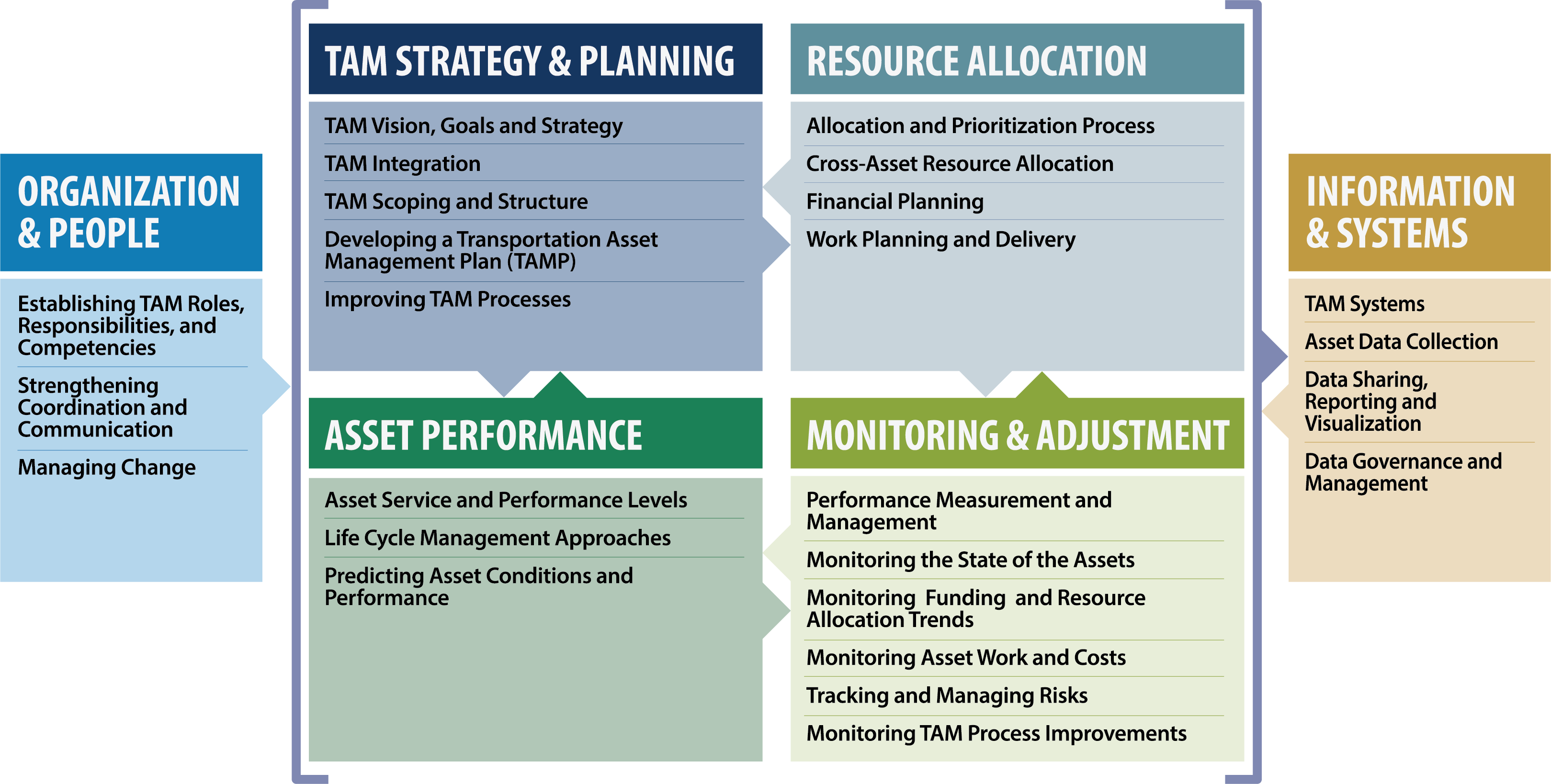1.2.1.1
TAM Guide Scope
The AASHTO TAM Guide Framework groups the components of asset management into six basic areas. The four central areas in the figure capture the business processes involved in asset management.
TAM Strategy & Planning
An organization manages its assets not as an end in and of itself, but to achieve broader goals. These goals might include improving mobility, enabling economic growth, and reducing costs to travelers and the environment. It is important to place TAM in the context of an agency’s broader goals and objectives, establish the scope of an agency’s TAM effort, and determine how TAM integrates with the other activities performed by the agency. A Transportation Asset Management Plan (TAMP) helps establish this context, and preparing such a document is consistent with best practices in TAM. Additionally, U.S. State transportation departments and transit agencies are now required to develop TAMPs to comply with Federal requirements.
Asset Performance
This encompasses the set of processes involved in determining how to manage an asset over its entire life, from construction or acquisition to maintenance and finally asset replacement or disposal. It addresses how to measure the level of service an asset is achieving and targets to achieve, how to best maintain an asset, and how to model the condition and performance of an asset in the future.
Resource Allocation
Managing assets requires determining how to best deploy a set of fi nite resources, including staff time, equipment, and budgets for operating and capital expenses. This area includes the processes involved in making resource allocation decisions, both for a given asset class, and across multiple asset classes considering a range of different objectives and constraints. Also, it addresses the development of financial plans summarizing expected sources and uses of asset management funds. TAM financial planning takes a long-term view of resource allocation to support the delivery of strategies that address asset needs at all stages of their service lives.
Monitoring and Adjustment
Ideally an organization’s approach to TAM and TAM-related decisions should be dynamic, with adjustments made in response to available data on asset conditions. This area includes processes related to measuring and monitoring asset performance, assessing risk, and making adjustments to investment decisions and business process to respond to changing conditions.
The remaining two areas detail factors that enable an improved asset management approach. The two enablers of an improved asset management approach are:
Information & Systems
TAM is very data intensive. It is important to have systems for tracking an organization’s inventory of assets and collecting needed data on asset conditions. Also, systems are often needed to connect to related data, including financial data and records of maintenance work. However, collecting asset data and implementing asset management systems can be costly and time consuming. It is important to develop an approach to information management that carefully considers what data are needed to support the organization’s goals, and how best to collect needed data.
Organization & People
All infrastructure-intensive organizations practice asset management in some manner. However, implementing a robust asset management approach incorporating best industry practices and a philosophy of continuous improvement requires having a robust organization and people with the correct mix of skills. Creating such an organization requires defining roles and responsibilities for TAM within an organization. Also, it is important to evaluate needed staff skills and to implement training programs to help existing staff improve their skillsets. Another important organizational factor is developing an approach for managing change within the organization to support a culture of continuous improvement.
The remainder of this guide further details the areas illustrated in the figure, with emphasis on those areas that are specific to TAM.
A basic feature of TAM is that it is interdisciplinary, and thus overlaps with a number of other areas, including but not limited to maintenance, project selection and budgeting, performance management, information technology, and risk. To the extent that other resources are available for addressing certain aspects of TAM, the text notes these overlaps and recommends other relevant resources.
The core elements illustrated in the TAM Guide Framework are further detailed in corresponding chapters of the Guide:
Chapter 1. TAM Basics discusses basic information of importance to any reader who is new to the concepts of transportation asset management.
Chapter 2. TAM Strategy & Planning discusses considerations in linking asset management to agency goals and objectives, and defining performance measures and targets for tracking progress.
Chapter 3. Asset Performance discusses developing life cycle plans that define how best to design, construct, operate, maintain and dispose of assets - and then executing those plans on a day-to-day basis.
Chapter 4. Resource Allocation details the process of making capital and maintenance investment decisions that provide the best long term performance given available resources, considering trade-offs and competing needs between different assets and investment objectives.
Chapter 5. Monitoring & Adjustment addresses topics including tracking asset health, responding to unplanned events, and managing risks to the asset inventory.
Chapter 6. Information & Systems addresses collecting needed asset data, and implementing management systems to support data collection and decision-making.
Chapter 7. Organization & People describes how to build an organizational structure that supports asset management, and develop processes for change management and training to build an awareness of asset management throughout the organization.
